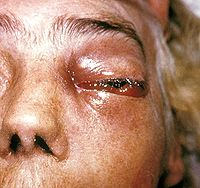
Photo from wikipedia
Pathogenic mucormycetes induce diseases with considerable morbidity and mortality in immunocompromised patients. Virulence data comparing different Mucorales species and various underlying risk factors are limited. We therefore compared the pathogenesis… Click to show full abstract
Pathogenic mucormycetes induce diseases with considerable morbidity and mortality in immunocompromised patients. Virulence data comparing different Mucorales species and various underlying risk factors are limited. We therefore compared the pathogenesis of inhalative infection by Rhizopus (R.) arrhizus and Lichtheimia (L.) corymbifera in murine models for predominant risk factors for onset of infection. Mice with diabetes or treated with cyclophosphamide or cortisone acetate were challenged via the intranasal route with an isolate of R. arrhizus or L. corymbifera, respectively. Clinical, immunological and inflammation parameters as well as efficacy of posaconazole prophylaxis were monitored over 14 days. Whereas immunocompetent mice showed no clinical symptoms after mucormycete infection, mice treated with either cyclophosphamide (CP) or cortisone acetate (CA) were highly susceptible. Animals infected with the isolate of R. arrhizus showed prolonged survival and lower mortality, compared to those exposed to the L. corymbifera isolate. This lower virulence of R. arrhizus was risk factor-dependent, since diabetic mice died only after infection with Rhizopus, whereas all Lichtheimia-infected diabetic animals survived. Under posaconazole prophylaxis, both mucormycetes were able to establish breakthrough infections in CA- and CP-treated mice, but the course of infection was significantly delayed. Detailed analysis revealed that susceptibility of CA- and CP-treated mice could not be mimicked by exclusive lack or downmodulation of neutrophils, platelets or complement, but can be supposed to be the consequence of a broad immunosuppressive effect induced by the drugs. Both Lichtheimia corymbifera and Rhizopus arrhizus induce invasive mycoses in immunocompromised hosts after inhalative infection. Key parameters such as virulence and immunopathogenesis vary strongly according to fungal species and underlying risk group. Selected neutropenia is no sufficient risk factor for onset of inhalative mucormycosis.
Journal Title: PLoS ONE
Year Published: 2020
Link to full text (if available)
Share on Social Media: Sign Up to like & get
recommendations!